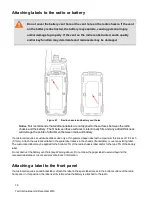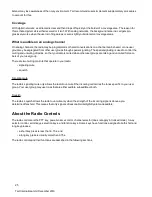
USA public safety bands
(764–776MHz and 794–806MHz)
The Code of Federal Regulations (CFR) Title 47 Subpart R deals with the use of frequencies in the 764 to 776MHz
and 794 to 806MHz bands.
Low-power channels
This radio complies with §90.531 (b) (3) and §90.531 (b) (4) of 47 CFR. These sections state that only low-power trans-
mission is permitted on the following channels:
• Regional Planning channels, as defined in §90.531 (b) (3).
• Itinerant channels, as defined in §90.531 (b) (4).
Use of encryption
This radio complies with §90.553 (a) of 47 CFR. This states that:
• Encryption is not permitted on the nationwide Interoperability calling channels. These channels are defined in
§90.531 (b) (1) (ii).
• Radios using encryption must have a readily accessible switch or control to allow the radio user to
disable encryption.
EMC regulatory compliance in Australia
This product meets all ACMA regulatory requirements for electromagnetic compatibility (EMC). For more information
about EMC compliance, visit the ACMA website at
.
Frequency band reserved for distress beacons
Frequency band 406 to 406.1 MHz is reserved for use by distress beacons. Transmissions should not be
made within this frequency band.
Health, safety and electromagnetic compatibility in Europe
In the European Community, radio and telecommunications equipment is regulated by Directive 2014/3/EU. The
requirements of this directive include protection of health and safety of users, as well as electromagnetic com-
patibility.
Intended purpose of product
This product is an FM radio transceiver. It is intended for radiocommunication in the Private Mobile Radio (PMR) or
Public Access Mobile Radio (PAMR) services, to be used in all member states of the European Union (EU) and
states within the European Economic Area (EEA).
Restrictions
This product can be programmed to transmit on frequencies that are not harmonized throughout the EU/EEA, and will
require a licence to operate in each member state.
This product can be programmed for frequencies or emissions that may make its use illegal. Where applicable, a
license must be obtained before this product is used. All license requirements must be observed. Limitations may
apply to transmitter power, operating frequency, channel spacing, and emission.
12
Tait International Ltd December 2019













































